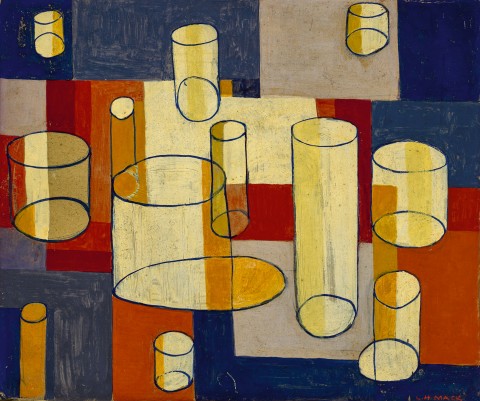COMPOSITION WITH CYLINDERS, c.1922
LUDWIG HIRSCHFELD-MACK
tempera on cardboard
37.5 x 44.5 cm
signed lower right: L. H. MACK
The estate of the artist
Private collection, Italy
Bauhaus e visioni, Museum of Modern Art, Bolzano, Vienna, 17 March – 28 May 2000; Jewish Museum of the City of Vienna, Austria, 14 June – 22 October 2000 and Jewish Museum Frankfurt, Germany, 13 December 2000 – 22 April 2001, cat. 62 (as ‘Untitled (Composition of planes with Cylinders)’)
Stasny, P., Ludwig Hirschfeld–Mack: Bauhaus e visioni, Hatje Cantz Verlag, Germany, 2000, cat. 62, pp. 69 (illus., as ‘Untitled (Composition of planes with Cylinders)’), 70, 173
Composition, 1922, watercolour over graphite on off–white wove paper, 21.1 x 25.7 cm, in the collection of Harvard Art Museums, USA
Ludwig Hirschfeld-Mack’s arrival in Australia aboard the infamous HMT Dunera in 1940 established a direct link between avant-garde European modernism and the development of twentieth century Australian art. An artist and a teacher, he had studied at the Weimar Bauhaus from 1919 until 1925. Founded by architect, Walter Gropius, in 1919, the Bauhaus was a highly influential school whose manifesto proposed a radical challenge: ‘Let us create a new guild of craftsmen, without the class distinctions which raise an arrogant barrier between craftsman and artist. Together let us conceive and create the new building of the future, which can embrace architecture and sculpture and painting in one unity’.1 The idealism and democratic approach that the school represented struck a chord with many following the experience of the First World War, and Hirschfeld-Mack’s first wife, Elenor, recalled, ‘We were all totally fulfilled by the new ideas that surrounded the Bauhaus.’2
Hirschfeld-Mack began his apprenticeship in the graphic printing workshop, learning various printmaking techniques and mastering the use of the printing press. His interests and creative output at the time however, incorporated a diverse range of activities which mirrored the breadth of Bauhaus teaching. Of particular note during this period, and indeed throughout his life, is Hirschfeld-Mack’s focus on colour and its theory, especially the farbenlichtspiele, or colour-light plays, in which he presented projected light compositions alongside a musical score. Despite his status as a journeyman (which followed the successful completion of an apprenticeship) rather than a master (as teachers were known), he also taught a colour seminar at the Bauhaus in the winter of 1922 – 23, and colour charts he made for these lessons are now held in the Bauhaus Archive, Berlin, as well as the collection of the Museum of Modern Art, New York.3
Painted during these years, Composition with Cylinders, c.1922 is characteristic of Hirschfeld-Mack’s Bauhaus abstraction, with an irregular patchwork of geometric shapes in red, blue and white providing the backdrop for a series of vertical cylindrical forms, which are open at each end. Line, form and colour combine to create a dynamic composition, as well as a sense of three-dimensional space in which the cylinders recede and advance in a jostling, rhythmic movement. Texture is often a distinctive feature of Hirschfeld-Mack’s paintings and here, brush strokes remain visible in the smooth surface of the tempera medium and the material qualities of the work are emphasised by a section of the cardboard support being left exposed. A closely related watercolour, which is dated 1922 and assumed to precede the painting, in the collection of Harvard University’s Busch-Reisinger Museum, tells us something about Hirschfeld-Mack’s working method. Although the colour palette is slightly varied – more purple and pink, than blue and red – the arrangement of background forms is very similar and the placement of cylinders is almost identical. While elements of the composition have been refined between the watercolour and the painting, it is evident that the artist’s clarity of intent, as well as a strong visual design were both present and well-formed from the outset.
1. Schwarzbauer, R. with Bell, C., Ludwig Hirschfeld-Mack: More Than a Bauhaus Artist, HistorySmiths, Melbourne, 2021, pp. 36 – 37
2. Ibid., p.36
3. Colour charts are also held in the collection of the Ian Potter Museum of Art, University of Melbourne, and the Busch-Reisinger Museum, Harvard University, see ibid., p. 49
KIRSTY GRANT
